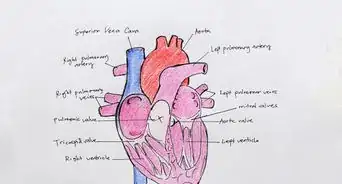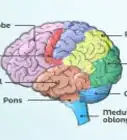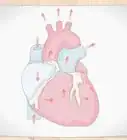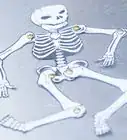This article was co-authored by Bess Ruff, MA. Bess Ruff is a Geography PhD student at Florida State University. She received her MA in Environmental Science and Management from the University of California, Santa Barbara in 2016. She has conducted survey work for marine spatial planning projects in the Caribbean and provided research support as a graduate fellow for the Sustainable Fisheries Group.
There are 10 references cited in this article, which can be found at the bottom of the page.
This article has been viewed 202,029 times.
Whether you plan on becoming a doctor or are simply looking to learn more about the human body, anatomy is an important subject that helps you understand how your body comes together and functions. Anatomy is a content-rich subject, though, and it can sometimes seem overwhelming if you do not have a good study plan. By making sure you are in the right courses, taking notes that cater to your needs, getting lab experience, and working with anatomical concepts outside of the classroom, you can enhance your study of the subject and get to know the human anatomy.
Steps
Learning in the Classroom
-
1Enroll in the right class for you. Are you a novice when it comes to anatomical studies, or do you have experience with the subject? Is there a particular component of anatomy, such as the skeletal structure or the central nervous system, that interests you? Make sure you are in an anatomy class that caters to your level of understanding and your needs.
- If you are new to studying anatomy, it is advisable to take an introductory course in order to provide you with basic concepts, theories, and terms that will be needed for your future studies.
- If you have the ability, you may want to ask a friend or peer who has previously taken an anatomy course if you can look over their notes and syllabus to see if the class meets your needs.
-
2Check your degree requirements. If you are studying anatomy as part of a diploma, degree, or certificate program, work with your academic advisor to make sure you are taking the correct course for your program. You may want to ask, “Does this course have a lab component that requires separate enrollment?” so that you can ensure you are in all of the right classes to get the credit you need.
- Check with your academic advisor regularly to make sure that your courses are correct.
Advertisement -
3Use visual aids. Anatomy deals with a large number of components of the human body. Use labeled diagrams and sketches in your notes so that you understand how the specific parts you study fit and interact in the rest of the body.[1]
- Ask your teacher, “Do you have any images or diagrams I can copy for study aids?”
- Use unlabeled versions of your diagrams or note sketches to test yourself and help reinforce your knowledge.
-
4Collaborate with your peers. Look to your classmates and see if you can create a study group or weekly meeting group to exchange notes and talk about the course. Use this time to have your peers help you with concepts that aren’t sticking with you.
- This is also a great space to help tutor your peers, which in turn allows you to review and reinforce information in your own mind.
- Make these meetings fun, informal spaces where you and your peers can talk freely about what you are learning. Allow for conversation, rather than the question and answer format you have in class.
-
5Teach the subject. Tutor for the subject, or teach your friends, your family, your roommates, or someone else who wants to learn more. Trying to teach is one of the best way to know whether or not you fully comprehend the subject, and this way you and your student both benefit.[2]
- Ask a friend or family member, “Can I try to teach you this particular anatomy concept?” Explain it to them as best as you can, and have them repeat it back to you. Use their informational gaps as guides for where you should study.
- Offer to tutor a lower grade level in their anatomy class. This gives you the chance to review material while helping another student of anatomy.
-
6Study related subjects. Anatomy has a lot of shared information with subjects such as embryology, comparative anatomy, and evolutionary biology. Enroll in classes in related subjects that might help you with your educational goals.
- Comparative anatomy and evolutionary biology look at how the human anatomical structure developed and how it relates to the anatomy of other animals.
- Embryology focuses on the development of sex cells in the womb up to birth.
Working in the Lab
-
1Learn to dissect. Anatomy resides inside the body. If you have the opportunity, watch or participate in a dissection. Try to study the cadaver as much as possible, relating what you have recently studied to what you see before you.[3]
- Discuss this with your labmates and listen to what they have to say, so as not to miss out on any insight. Try not to skip any dissection labs, even though you may not enjoy doing them. Little else can give you this hands-on experience.
- If you are truly opposed to human dissection, ask your teacher for guidance finding an online dissection module. This allows you to digitally dissect the body without actually having to work with a cadaver.
-
2Look for what is different. Anatomy books focus on the average human condition, but no individual is going to completely align with the average condition. Take a look while you are in the lab at what may be different than in your book to get an understanding of what is normal and what is abnormal.[4]
- Talk with your teacher about your observations. Ask them, “If a certain condition is considered average, is what I observed considered abnormal or problematic?”
- Always follow up by asking, “Why is that?” so that you understand not only how certain parts of the body may differ, but also why.
-
3Write in-depth lab reports. You are likely graded on your lab reports, but you should think of them as a tool for your as well as a grade. Write in-depth, well-researched lab reports that contains not only the information requested by your teacher, but also information you find valuable.[5]
- Your report should include your hypothesis, your tests, your raw data, and your interpretations of the data.
- Use your data interpretation to include information from your course and from other sources such as peer-reviewed journals and monographs. Make notes of why you think what you think in your lab report.
Studying Independently
-
1Do the readings. Your assigned readings are there for a reason. Read your textbook and any assigned articles, and take notes as you go through if any concept confuses you. Set a reminder for yourself to ask questions about your reading during or after class.[6]
- Look for supplemental readings that may engage you, such as medical novels or historical accounts of early dissections. Make notes of what you find interesting and what you think might be inaccurate so that you can ask your peers or teacher.
-
2Find an online resource. Use online modules or tutorials to help reinforce the information you learn. You may even opt to use online models to help you recognize parts of the body, or create digital flashcards to help you study.[7]
- Use online materials as a supplement to your studies. Do not expect to get all of the information you need to know strictly from online materials. Lab and class time are equally important in studying anatomy.
-
3Look into an open learning program. If anatomy is an interest or hobby rather than part of your formal education, look at learning through an open platform such as Coursera [8] or the Open Learning Initiative.[9] These allow you to connect with courses from universities all over the world for free.
- If a general anatomy course is not being offered, look for a specialized one to get you started in your studies.
- These courses include a lot of material, but are largely self-directed. Do all of the readings, assignments, quizzes, and discussion posts to get the most out of them.
-
4Write concepts in your own words. Take large or complicated concepts and rewrite them in your own words. Instead of trying to memorize your book, break down concepts in your own terms so that you better understand them when you review them.
- Try using flash cards with the concept on the front, and your description on the back. Use these to review as you study.
- You may also find it useful to use mnemonic devices to help you remember key concepts or phrases. For example, the word "SCALP" can help you remember the anatomical layers of the scalp (skin, connective tissue, aponeurosis, loose connective tissue, periosteum).[10]
- You should also go through anatomy drawings while studying the concepts.
-
5Study Greek and Latin. Medical terminology is full of Greek and Latin roots and words. For example, the cardiovascular system comes from the Greek root καρδιά (kardia), which means heart. Look for books or online lessons in basic Greek or Latin to help you more easily understand medical terminology.
- There are many publications that focus on Greek and Latin roots for medical students. Check online or with your local book store to find specialized text for anatomy students.
- Use online learning modules and focus on lessons about body parts or medical terms.
- It's easier and more efficient to skip grammar and focus only on the relevant vocabulary, since you won't need to speak or read actual Greek or Latin, only words rooted in those languages.
Community Q&A
-
QuestionWhich books are best for anatomy?
 Community AnswerFor a build up from basics, Moore's clinical anatomy is perfect. Its descriptions are easy to read and understand. If you are looking for a anatomy atlas. Gray's atlas has amazing diagrams. For live pictures, refer to McMinn's atlas.
Community AnswerFor a build up from basics, Moore's clinical anatomy is perfect. Its descriptions are easy to read and understand. If you are looking for a anatomy atlas. Gray's atlas has amazing diagrams. For live pictures, refer to McMinn's atlas. -
QuestionI bought an anatomy colouring book by The Princeton Review as a result of my interest in Anatomy. I'm 12 and do not have much knowledge on Anatomy so how do I make the best out of it?
 Community AnswerTry using your coloring book as a supplemental guide to accompany your anatomical studies. Label the body parts as you color, and use other books or information that you learn in your own studies to help you figure out the names and locations of certain parts.
Community AnswerTry using your coloring book as a supplemental guide to accompany your anatomical studies. Label the body parts as you color, and use other books or information that you learn in your own studies to help you figure out the names and locations of certain parts. -
QuestionAnatomy books are very heavy and there's a lot of content. It seems like too much, how can I study?
 HjayCommunity AnswerFirst of all, you must know that from which book you should study. Then start from the basics. Studying medicine is something that requires attention, focus, hard work and consistency. If you are consistent only then you can ace it without any stress. You can ask your instructors for guidance. Taking part actively in small group discussions helps a lot. Avoid cramming the concepts. Understand the clinical importance of what you study.
HjayCommunity AnswerFirst of all, you must know that from which book you should study. Then start from the basics. Studying medicine is something that requires attention, focus, hard work and consistency. If you are consistent only then you can ace it without any stress. You can ask your instructors for guidance. Taking part actively in small group discussions helps a lot. Avoid cramming the concepts. Understand the clinical importance of what you study.
Warnings
- Make sure to always be reading the most recent edition of whatever book you have.⧼thumbs_response⧽
References
- ↑ http://www.uefap.com/reading/notetake/notetake.htm
- ↑ http://www.potsdam.edu/support/ssc/sss/tutors/10rules
- ↑ https://www.ncbi.nlm.nih.gov/pmc/articles/PMC4582158/
- ↑ http://www.livescience.com/29083-importance-of-anatomy-labs.html
- ↑ http://writingcenter.unc.edu/handouts/scientific-reports/
- ↑ http://www.nea.org/home/34689.htm
- ↑ https://www.getbodysmart.com/
- ↑ https://www.coursera.org/
- ↑ http://oli.cmu.edu/courses/free-open/anatomy-physiology/
About This Article
To study anatomy, try to use visual aids when you study, like labeled diagrams and sketches, since anatomy deals with a lot of different parts in the human body. You can also use online modules and tutorials to help you study, as well as digital anatomy flashcards. As you're studying, rewrite complicated concepts in your own words so they're easier to memorize. Also, use mnemonic devices to help you memorize concepts and phrases. For more tips from our Science co-author, like how to study anatomy in a lab, read on!









































































